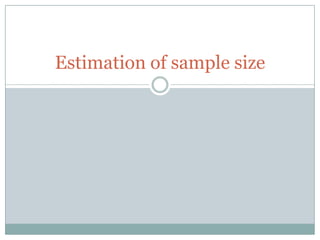
Estimation of sample size
- 1. Estimation of sample size
- 2. Determination of sample size through the Approach based on precision Rate and Cofidence Level The Sampling menu has two selections: Sample size for proportion Sample size for means
- 3. Sample size for Proportion This menu selection is used to determine the required size of a sample for research questions involving percents. Four questions must be answered to determine the sample size: 1. Best estimate of the population size: You do not need to know the exact size of the population. Simply make your best estimate. An inaccurate population size will not seriously affect the formula computations. If the population is very large, this item may be left blank. 2. Best estimate of the rate in the population (%): Make your best estimate of what the actual percent of the survey characteristic is. If wedo not know, then enter 50 (for fifty percent).
- 4. 3. Maximum acceptable difference (%): This is the maximum percent difference that you are willing to accept between the true population rate and the sample rate. Typically, in social science research, you would be willing to accept a difference of 5 percent. That is, if your survey finds that 25 percent of the sample has a certain characteristic, the actual rate in the population may be between 20 and 30 percent. 4. Desired confidence level (%): How confident must you be that the true population rate falls within the acceptable difference (specified in the previous question)? This is the same as the confidence that you want to have in your findings. If you want 95 percent confidence (typical for social science research), you should enter 95. This means that if you took a hundred samples from the population, five of those samples would have a rate that exceeded the difference you specified in the previous question.
- 5. Example A publishing wants to know what percent of the population might be interested in a new magazine on making the most of your retirement. Secondary data (that is several years old) indicates that 22% of the population is retired. They are willing to accept an error rate of 5% and they want to be 95% certain that their finding does not differ from the true rate by more than 5%. What is the required sample size? Best estimate of the population size: (left blank)Best estimate of the rate in the population (%): 22Maximum acceptable difference (%): 5Desired confidence level (%): 95 ------------------------------------------------------------- Required sample size = 263
- 6. Sample size for means This menu selection is used to determine the required size of a sample for research questions involving means. Three questions must be answered to determine the sample size: 1. Standard deviation of the population: It is rare that a researcher knows the exact standard deviation of the population. Typically, the standard deviation of the population is estimated a) from the results of a previous survey, b) from a pilot study, c) from secondary data, or d) or the judgment of the researcher. 2. Maximum acceptable difference: This is the maximum amount of error that you are willing to accept. That is, it is the maximum difference that the sample mean can deviate from the true population mean before you call the difference significant. 3. Desired confidence level (%): The confidence level is your level of certainty that the sample mean does not differ from the true population mean by more than the maximum acceptable difference. Typically, social science research uses a 95% confidence level
- 7. Example A fast food company wants to determine the average number of times that fast food users visit fast food restaurants per week. They have decided that their estimate needs to be accurate within plus or minus one-tenth of a visit, and they want to be 95% sure that their estimate does differ from true number of visits by more than one-tenth of a visit. Previous research has shown that the standard deviation is .7 visits. What is the required sample size? Population standard deviation: .7Maximum acceptable difference: .1Desired confidence interval (%): 95 -------------------------------------------- Required sample size = 188